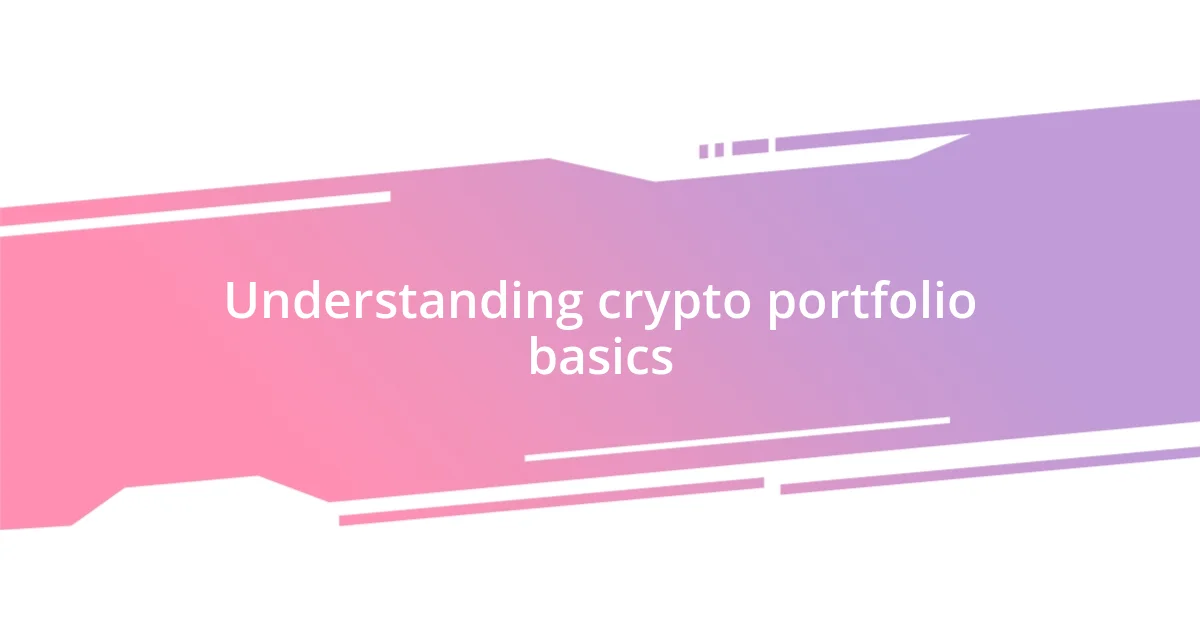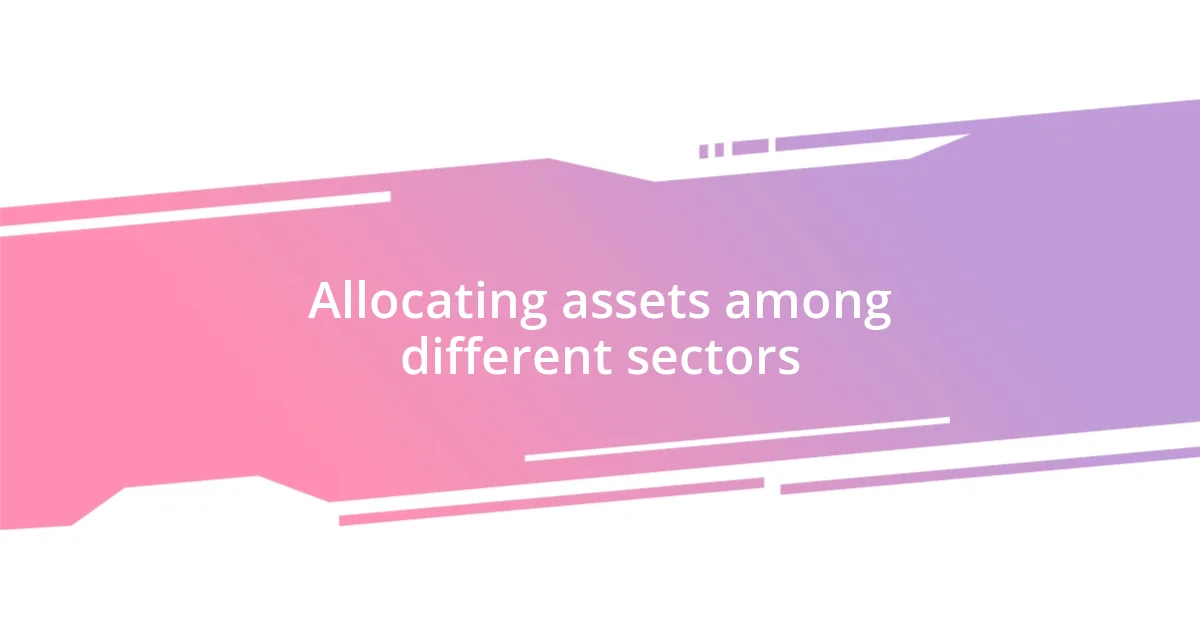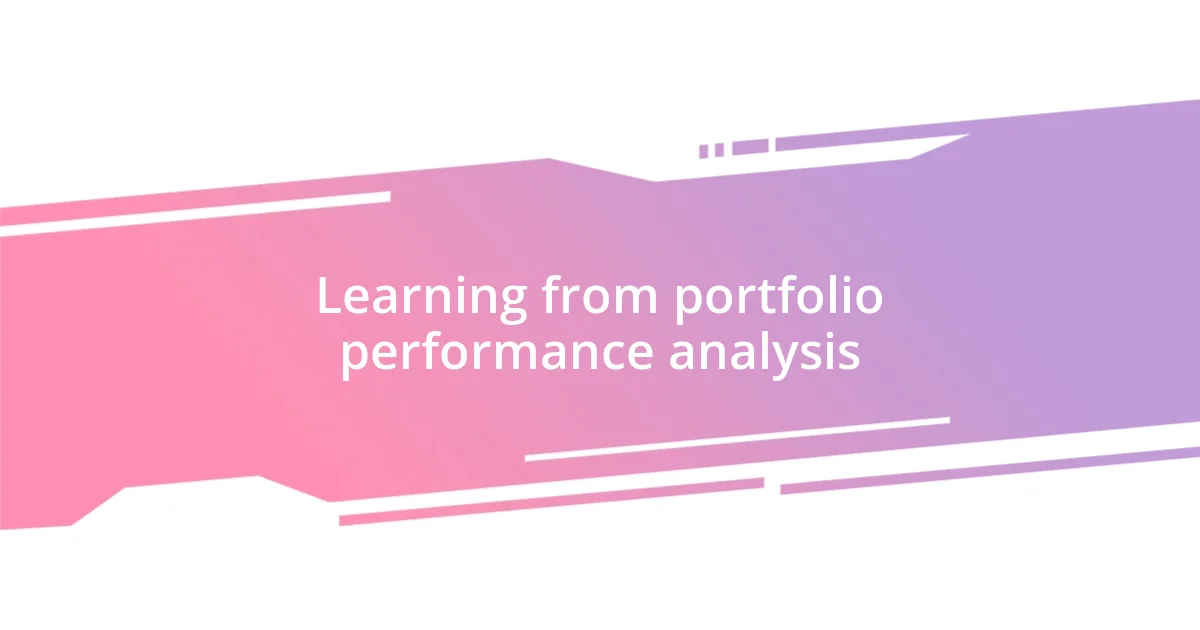Key takeaways:
- Diversification is essential for managing risk in a crypto portfolio, involving investments in a variety of cryptocurrencies based on their purpose and risk level.
- Regularly rebalancing your portfolio helps maintain balance and align investments with financial goals, allowing for better decision-making and risk management.
- Utilizing tracking tools and performing regular performance analysis enhances investment strategies by providing insights, enabling informed decision-making, and fostering growth from past mistakes.

Understanding crypto portfolio basics
A crypto portfolio isn’t just a collection of coins; it’s a strategic blend that reflects your risk tolerance and investment goals. I remember when I first ventured into crypto, I was overwhelmed by the dizzying array of options. It made me ask myself—how do I even begin to choose?
Diversification, in essence, involves spreading your investments across various types of cryptocurrencies. I learned that putting all my money into one asset can be as risky as walking a tightrope without a safety net. By investing in different categories—such as established coins like Bitcoin, promising altcoins, and even emerging tokens—I found a balance that felt more secure.
It’s also essential to consider the purpose of each asset in your portfolio. Some of my coins are for long-term growth, while others serve as a safety net or a gamble on innovation. Have you thought about how each cryptocurrency aligns with your personal financial story? Reflecting on this can clarify your strategy and empower your investment decisions.

Assessing risk tolerance for investments
Evaluating your risk tolerance is crucial in any investment strategy, especially in the unpredictable world of cryptocurrencies. When I first started, I naïvely thought all risks were manageable, until a sudden market drop wiped out a significant portion of my portfolio. That moment taught me the importance of understanding how much volatility I could actually handle without losing sleep at night.
It’s all about self-reflection. Consider what you’re willing to lose and how that aligns with your financial objectives. For instance, I remember grappling with a decision about whether to invest in a highly volatile coin or stick with a more established option. After weighing my anxiety against potential rewards, I chose a balanced approach. Balancing confidence with cautiousness helps navigate the unpredictable waters of crypto investing.
To make this process clearer, I recommend categorizing your investments based on risk levels. Here’s a table to help visualize the differences:
| Investment Type | Risk Level |
|---|---|
| Established Coins (e.g., Bitcoin, Ethereum) | Low |
| Mid-Cap Altcoins | Medium |
| Emerging Tokens | High |
By understanding these categories, I found it easier to decide where to allocate my funds while accommodating my risk tolerance. What about you? Have you ever evaluated how different investments fit into your risk comfort zone?

Selecting diverse cryptocurrencies to invest
Selecting diverse cryptocurrencies for investment is a process that requires thoughtfulness. I recall my initial attempts at diversifying; I made the mistake of picking coins based solely on trends or social media hype. It wasn’t until I dug deeper into the unique value propositions of each cryptocurrency that I started to see real potential in my investments. When selecting cryptocurrencies, I strive for a mix that includes established players, innovative projects, and those with niche utilities:
- Established Coins: Like Bitcoin and Ethereum, which offer stability and wide acceptance.
- Mid-Cap Altcoins: Promising projects with solid fundamentals, such as Cardano or Solana, which can provide growth potential.
- Emerging Tokens: New entrants like decentralized finance (DeFi) projects that may offer high rewards but come with increased risk.
In my experience, a balanced approach helps mitigate potential losses while allowing for gains. I often remind myself to look beyond just market buzz—understanding the community, the technology, and even the team behind a project can make all the difference in my decision-making process. It’s like being an investor and a detective rolled into one!

Allocating assets among different sectors
Allocating your assets among different sectors within the crypto space can feel overwhelming, but I’ve found that breaking it down makes it manageable. For instance, I typically spread my investments across three main sectors: finance, technology, and utilities. This strategy not only diversifies my risk but also allows me to tap into various market cycles. Reflecting on my early days, I regret not having embraced this approach sooner; focusing too heavily on just one area left me vulnerable to the sudden shifts in market sentiment.
While experimenting with this allocation strategy, I’ve noticed that different sectors often perform differently under varying market conditions. For example, during a crypto winter, DeFi projects can take a hit while utility tokens may hold up better. I remember during a particularly tough market downturn, I had a solid chunk in DeFi platforms, and seeing their value plummet was a harsh lesson. I’ve since learned to balance my portfolio with some tech-focused coins, which can sometimes provide unexpected resilience in tough times. Segmentation really does matter!
Have you considered how you allocate your assets among these different sectors? Each choice can significantly impact your overall performance. Just like in traditional investing, diversifying across sectors not only spreads the risk but also enhances opportunities for returns. I’ve personally experienced the benefits of having a well-rounded portfolio, and I encourage everyone to think critically about the sectors they are investing in. This mindset can truly transform your approach to crypto investing!

Regularly rebalancing your portfolio
Regularly rebalancing my crypto portfolio has been a game changer for me. Initially, I would let my investments ride the market waves, but I quickly realized that this could lead to skewed risk. By reviewing and adjusting my allocations every few months, I maintain balance and ensure that no single asset dwarfs the others, keeping my risk in check. How often do you think about rebalancing yours? I find that regular check-ins help me stay aligned with my investment goals.
There was a time when my holdings in one particular altcoin surged, and I felt thrilled watching my profits grow. However, I neglected to rebalance, and when the coin’s value took a nosedive, it was a tough pill to swallow. Now, I create a clear strategy to pull profits from winners and reallocate to other areas, which not only manages risk but allows me to capitalize on emerging opportunities. Each time I rebalance, I feel a sense of control and confidence over my investments that I didn’t experience early on.
I’ve learned that rebalancing isn’t just about numbers; it’s a mental exercise that forces me to reflect on my entire investment narrative. I often ask myself: “Am I still invested in projects that align with my long-term vision?” This reflection gives me clarity and reinvigorates my commitment to the journey. It’s fascinating how a simple practice can bring a renewed perspective to my investment approach, turning a potentially stressful task into a thoughtful strategic exercise.

Using tools for tracking investments
Tracking my crypto investments has evolved into an essential part of my strategy. Over time, I’ve explored various tools and apps designed to simplify the process, and I can honestly say that some have transformed the way I manage my portfolio. For example, I discovered an intuitive platform that aggregates all my holdings in one place, making it easy to view changes in real-time. Have you ever tried using a tracking tool that just seemed to click for you?
I vividly remember the early days when I relied heavily on spreadsheets, which quickly became chaotic as my portfolio grew. The constant manual updates were both exhausting and stressful. When I switched to a dedicated app with alerts for price changes and performance analytics, I felt a wave of relief wash over me. This tool not only reduced my anxiety but also encouraged me to stay informed without constantly obsessing over the market. The convenience of having data at my fingertips has made a remarkable difference in how I approach my investments.
Additionally, using portfolio tracking tools has helped me analyze my performance without getting lost in the noise. By visualizing my asset allocation and historical performance, I can identify trends and make informed decisions. I often find myself reflecting on past investments; it’s amazing what insights a good tracking tool can provide. Have you found ways to measure your performance that resonate with you? Each quarter, I make it a habit to review my data, and it’s not just numbers to me — it’s like getting a pulse check on my financial journey.

Learning from portfolio performance analysis
Analyzing my portfolio performance regularly has been enlightening. I remember this one particular review where I noticed that a few altcoins had stagnant growth, while a couple of others were outperforming. Reflecting on this led me to reallocate funds towards the stronger performers, enhancing my overall returns. Have you ever felt that rush of excitement when you realize your analysis leads to better decisions? It’s moments like these that illustrate the power of being proactive.
One of my biggest revelations came when I analyzed my losses, not just my gains. Initially, it felt discouraging to confront underperforming assets. However, digging deeper into why they weren’t meeting expectations opened my eyes to better investment principles. I learned to ask, “What was I missing?” This self-reflection transformed disappointment into an opportunity for growth, reshaping how I view setbacks.
Over time, I’ve realized that portfolio performance analysis does more than just inform; it evolves my investing mindset. Each time I assess my investments, I align my choices with my financial goals. It’s a bit like tuning a musical instrument; with each adjustment, the harmony gets better. Do you regularly tune into your portfolio’s performance? I find that it’s not just about the numbers — it’s about creating a balanced and harmonious investment approach.














